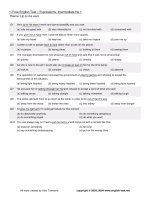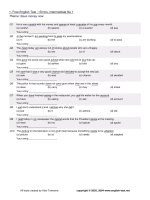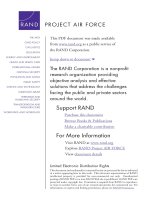Intermediate macroeconomics chapt15
Bạn đang xem bản rút gọn của tài liệu. Xem và tải ngay bản đầy đủ của tài liệu tại đây (314.72 KB, 17 trang )
Chapter 15:
Government Debt &
Budget Deficit
Deficit & Debt
Federal deficit occurs when government spending
(purchases & transfers) exceeds tax receipts
Federal debt is the amount of funds the government must
borrow to cover its deficit
Money is owed to government agencies, private individuals
and firms, and foreign individuals, companies, and
countries
Size of Debt
Size of the debt is measured by the debt ratio:
government debt as a percentage of the GDP
Debt ratio in U.S. in 1998 = 65, less than Belgium (125),
Italy (123), and Japan (93), but more than Australia (40),
Finland (59) and U.K. (60)
The Debt-GDP Ratio
The Debt-GDP Ratio (US)
Change in Debt Ratio
Revolutionary War = 45
Civil War = 40
WW I = 40
WW II = 120
In recent years, the ratio increased from 22 in 1970 to 40
in 1980 to 60 in 1990 and to 65 in 1998
Deficit & Debt Projections
2000
2010
2020
2030
2040
T
21
G
21
Deficit 0
Debt 42
20
20
-1
21
20
22
1
17
20
25
5
40
20
30
10
93
All variables are expressed as percentage of GDP
2050
20
43
23
206
Deficit & Debt Projections
Receipt shall stay constant at 20%
Spending shall rise from 21% in 2000 to 22% in 2030 to
43% in 2050
Deficit shall rise from –1% in 2010 to 23% in 2050
Debt falling to 17% in 2020 shall rise to 93% in 2040 and
206% in 2050
Measurement Problem 1
Calculating deficit in “nominal” value results in an
overstatement of the amount of debt required to cover the
deficit
Deficit and debt must be expressed in “real” values; i.e.
adjusted for inflation
Measurement Problem 2
Unlike private accounting procedures, government debt
does not measure the difference between government
assets and liabilities
Capital budgeting, that accounts for assets and liabilities,
measures changes in capital
Measurement Problem 3
Government debt does not account for Social Security
liabilities
Unlike public debt, the government can refuse making
Social Security payments if funds are insufficient
Measurement Problem 4
Deficit and debt move pro-cyclically: they fall during a
slump and rise during a boom
To solve this problem, the government calculates a
“cyclically-adjusted” budget deficit, which the amount of
deficit at full employment
Traditional View of Debt
A tax cut increases disposable personal income,
consumption spending, employment, and income. A
higher AD results in higher income and real interest rate as
the IS curve shifts to the right.
In the long-run, price level will rise, lowering SRAS to
reduce income to its full employment level
Ricardian View of Debt: Analysis
Forward-looking consumers may not spend their additional
disposable income to cause growth
With a tax cut, people shall expect a future spending cut
as the government would not want to run a deficit
Likewise, consumers view debt accumulation as a sign of
higher future taxes, thus saving money for that purpose
Ricardian View of Debt: Case Study
In early 1992, President Bush reduced the federal income
tax withholding requirement to increase disposable income
and stimulate growth
Forward-looking consumers expecting larger tax liabilities
in April, did not spend the additional income to help the
economy grow
Ricardian View of Debt: Burden
Parents learning that debt operates as a negative future
transfer payment, would not spend as much during their
lifetime
Parents save and accumulate assets to pass money on to
their children and grand children
Position of the FED
A substantial reduction in long-term prospective deficit will
significantly lower long-term inflation expectations
Inflationary financed growth results in increased tax
revenues and government spending to cause deficit and
inflation
Deficit financed growth increases debt with no real income
growth, but higher inflation









